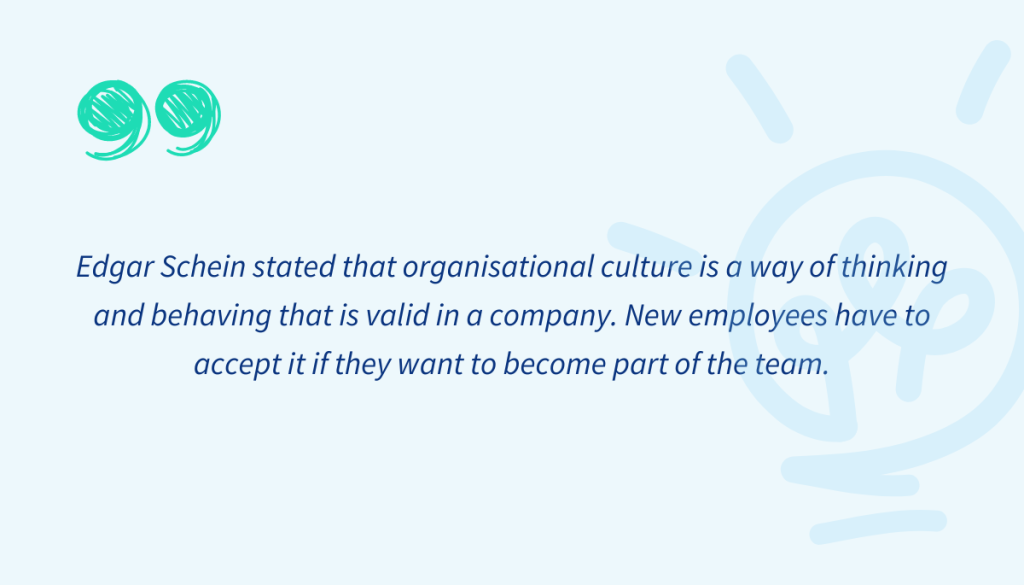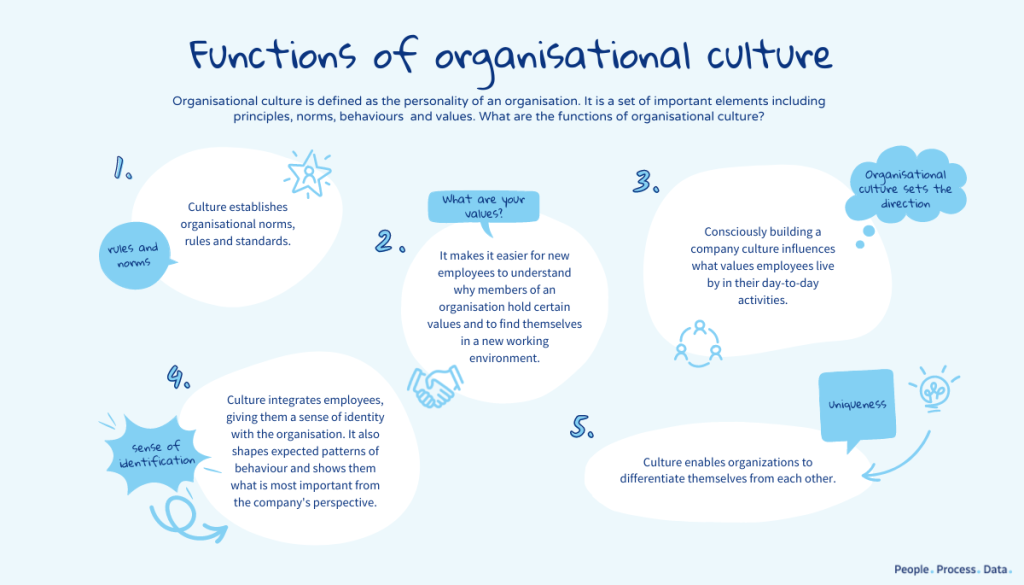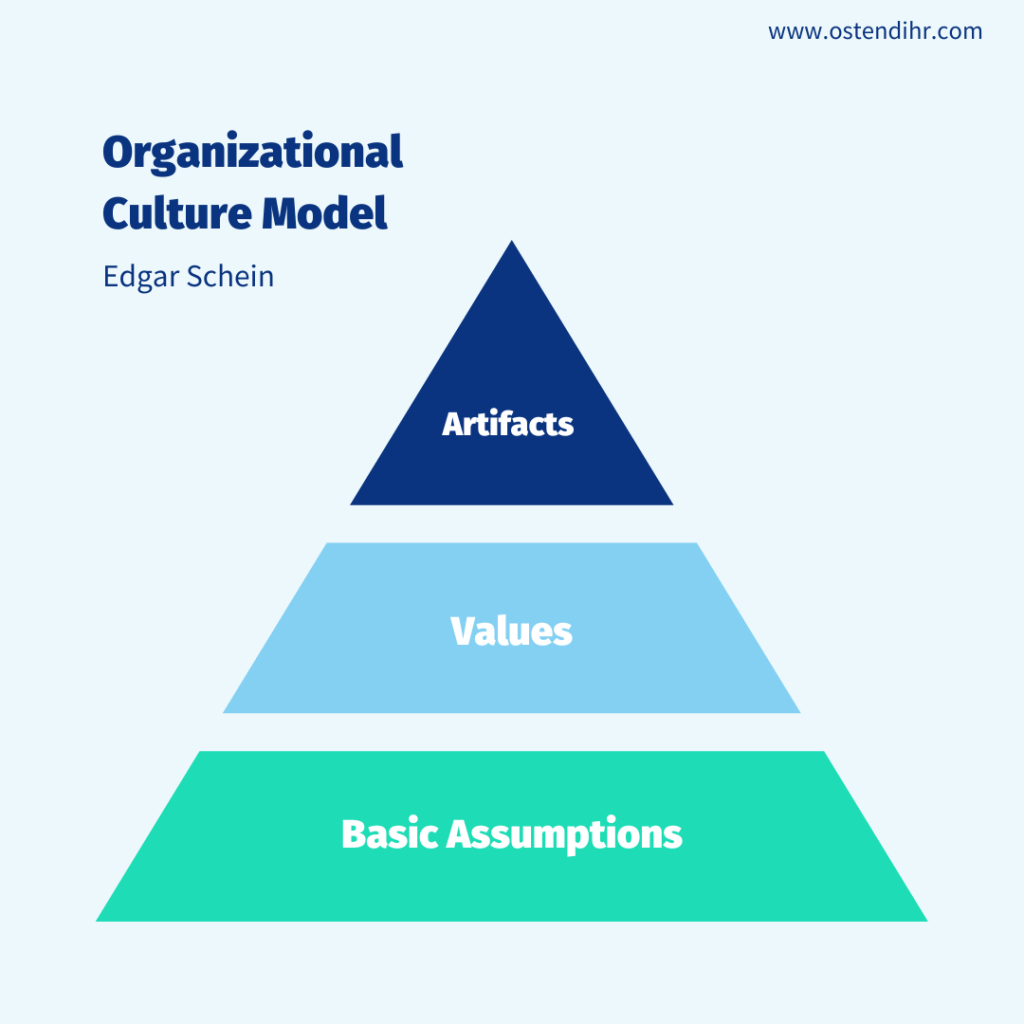Table of contents:
- What is organisational culture?
- Organisational culture elements
- Organisational culture functions
- Organisational culture types
- A committed workplace culture
- Building a strong organisational culture
- Which organisational culture is the best?
What is organisational culture? More and more, it is what matters to employees. Good financial performance, innovative measures and professional development opportunities are not enough.
Nobody would want to work in an environment where they feel uncomfortable. How do you ensure that employees stay in a particular workplace for the long term? Organisational culture has an increasing influence on the level of employee turnover in an organisation.
What is a organisational culture?
It is extremely difficult to define exactly what organisational culture is.
The term was first used by Elliott Jacques, a physician and psychologist from Canada. He stated that it is the way of thinking and behaving in a company. New employees must accept it if they want to become part of the team.
The American social psychologist, Edgar Schein, also attempted a definition of organisational culture. He defined it as a pattern of basic rules developed and approved by current employees. He also stated that new employees should assimilate it as the right way of thinking.

Organisational culture elements
Edgar Schein, mentioned above, identified three levels of organisational culture:
- artifacts
- basic assumptions
- accepted norms and professed values
The artifacts of organisational culture are divided into linguistic, physical and behavioural.
Linguistic artifacts
The first of these include myths and stories about the company and its distinctive vocabulary. The use of specific language has a cultural dimension in addition to its utilitarian nature. And getting to know sayings and phrases that are only understandable after learning about the culture and history of the company is a process of initiation. Passing on founding myths and stories about the team builds the new employee’s emotional relationship to the given company.
Physical artifacts
These are all the material elements that are associated with an organisation. We are talking about the dress code in force, the buildings belonging to the company, the colour and appearance of the car fleet or how the interior furnishings look. This is very important because it has a direct impact on the productivity of employees and their level of commitment.
The choice of paint colours on the walls, the presence of plants in the office, the way in which the workstations are planned, all have a considerable impact on the wellbeing of employees. In addition to this, the presence of company-specific logos or colour accents is important.
Behavioural artifacts
These are the savoir-virvre of employees at every level and the way they behave towards customers and each other. Of particular importance are the representatives of the managerial division, who, even in informal conversations, set an example for others in the company. Behavioural artefacts also include any rituals, team-building outings and joint celebrations of company successes.
Core assumptions and values held by members of the organisation
The second level described by Schein is the company’s core assumptions. These are the core beliefs that set the direction for the organisation and its members.
The last level of organisational culture is formed by the values and norms adopted and adhered to by all employees. They define what is considered good in front of a given company and what is not acceptable under any circumstances. It can be said that they form the foundation of the entire organisational culture.
Organisational culture functions
Based on the definitions, there are several key functions of organisational culture.
- it helps to understand why employees adhere to certain values
- it demonstrates the company’s mission and vision
- it integrates members of the organisation
- it reduces turnover rates
Consciously building an organisation’s culture is beneficial for both employees and the employer. Members of the organisation need to see the meaning of their work and understand why they should perform their duties and how this results in the achievement of business goals. Developing a company culture also has an impact on how a company is perceived. If employees believe in the institution, they have a belief that there is value in doing work for it. This all translates into their commitment, satisfaction and identification with the brand.

Organisational culture types
It is impossible to describe all types of organisational culture, as each company creates its own unique culture. What characterises a high organisational culture is the adherence to role models and the fact that the values espoused actually manifest themselves in the day-to-day actions of not only the rank-and-file employees, but also managers, board members and the owners themselves.
Charles Handy, in his book Gods of Management (Profile Books Ltd, 2020), distinguished 4 basic types of culture: power, task, role and person.
Power culture
Characterised by a single decision-maker bringing together a circle of power. It is very common in the military, in the police, in crisis headquarters, where quick and decisive decisions are needed. In business, we can find it in young owner companies. Decision-making is centred around the figure of the CEO.
Consistently, this also means that those in managerial positions have no real influence on decisions taken in the company. The big downside of this type of culture is that the possible absence of the owner significantly delays the decision-making process. In the long term, it also has a demotivating effect on the commitment of employees who, in this type of company, become passive after a while.
Task culture
This is a company focused on planning tasks. What counts most is competence – once a task has been entrusted to an employee, there is no need to constantly monitor its implementation. It is a kind of hierachy – how one performs the assigned tasks and whether one is an expert in a particular field determines this. Knowledge and experience are the most important factors to consider when selecting project managers and executives. A big plus of this type of culture is its flexibility. The danger, on the other hand, is that not every specialist is a good manager.
Role culture
In this type of culture each employee performs specific tasks and their position has a clearly defined place in the hierarchy. Consequently, those seeking promotion are well aware of the requirements they must first fulfil. This enables them to plan their career path at the very beginning. This type of organisational culture is also called bureaucratic. It is very common in government departments and universities. What matters most in this case is whether all tasks are carried out to the letter of the law.
Person culture
Characteristic of an organisation in which professionals with a similar level of experience and competence work. In practice, it is most often found in associations, where individual members are expected to pursue individual goals. In turn, the role of the leader is reduced to creating a comfortable working environment. Very often this type of culture is referred to as an individual culture. It is found in arts organisations, where freelancers do their work.
In addition to the typology distinguished by Charles Handy, there are many other types of organisational culture.
Agile culture
This type of culture involves giving responsibility to individual teams for assigned duties. It is based on well-defined short task cycles, called, for example, a sprint. A project coordinator oversees their implementation on an ongoing basis. An important element in this type of culture is cyclical, daily meetings consisting of a brief, factual discussion of tasks. This is also a space for quickly flagging up any problems that arise. This model of culture is extremely transparent, as the entire team working on a given problem knows exactly what stage of implementation it is currently at. A major difficulty in introducing this type of culture is the need for constant and efficient communication. For this, the right tool is required.
Teal organisation
The concept of a teal organisation originates from a concept developed by Frederic Laloux. In his work1, he identified 5 colours that define the different stages of a company’s development. One of these is teal, which represents an organisation in which there is no hierarchy, responsibility for tasks is borne individually and functions performed are more important than positions. Although there are numerous advantages of this system, it is extremely difficult to put into practice, as this type of people management is not based on what is widely known and often used (e.g. a hierarchical employee structure, periodic appraisal interviews or a bonus system), but on trust, cooperation and partnership. However, if this process is successful, members become more creative and feel more motivated.
A committed workplace culture
Building an engaged workplace culture is a task that takes years. The key to making a workplace culture effective and efficient is proper communication. This is an extremely important aspect that affects not only the culture, but also the performance of the entire company. Proper internal communication increases employee engagement, their identification with the brand and the way they perceive their organisation. Email notifications or printed newsletters are the most popular tools for communicating information.
Internal communication aims to provide updates on the life of the company and its product offering, to exchange experiences, to share good practices and to warn against reproducing mistakes. There are many reasons to take care of it, but among them one stands out. It is about increasing the involvement of employees in the life of the company and integrating them around a common, clearly defined business goal.
Giving feedback to a specific member of the organisation is not an easy task. Research conducted by the consultancy Zenger-Folkman2 shows that just over 92% of respondents believe that skilfully delivered feedback can contribute to improving a company’s financial performance in a significant way.
We have written a separate article on how to give feedback in the new reality, which we warmly encourage you to read. In addition, it is worth remembering that cyclical processes such as the 360 appraisal and the engagement and feedback survey also have an impact on building a strong organisational culture based on feedback.

Building a strong organisational culture
It is worth looking at good practices to support building an engaging organisational culture. The whole process starts at the recruitment stage. Even then, it is worth paying particular attention to the candidate’s values and making sure that the organisation’s values and principles are consistent with the candidate’s expectations.
- Training
Organisational culture should primarily be built by skilfully passing on knowledge and good practices in the organisation to new employees. How better to learn the secrets of a company’s operation than through practice? During training, it is worth presenting and underlining the values that guide the organisation and expecting these principles to be respected at every stage of the tasks assigned. At this point, it is also worth emphasising the special role of superiors vis-à-vis new hires in the context of building the organisational culture, who should be its ambassadors.
- Feedback
The creation of organisational culture is influenced by constructive feedback. Although feedback usually has a negative connotation, by this term it can also be understood as appreciation for contributions and naming positive actions. It is also important to communicate one’s expectations regularly and honestly and to react quickly when undesirable behaviour happens.
- An example to follow
Organisational culture is largely shaped by the managers, the board of directors and the CEO of a company. Their style of communication, the way they treat other members of the organisation and customers, and the standards of behaviour they present have a huge impact on the organisation’s culture. They are the ones who should set an example to others of an impeccable employee who adheres to the organisation’s declared values and reproduces accepted patterns of behaviour. Therefore, if we care about the company’s development and good atmosphere, we should not entrust people who act unethically.
Which organisational culture is the best?
Every organisation develops its own unique culture over time. There are no right or wrong choices, as each has both pros and cons. Consider which type of culture described above is best suited to your organisation’s needs. And then start implementing it.
New generations are entering the labour market. Their expectations are completely different from what has been known before. A committed work culture, work-life balance, competence development and mental health care – these are the aspects they look for when selecting a potential employer. Organisational culture makes employees more willing to work for a company and want to stay longer. Develop it consciously and you and your organisation will benefit.
______
Bibliography:
- Jack Zenger and Joseph Folkman, „Your Employee Want the Negative Feedback You Hate to Give”, Harvard Business Review, 2014.
- Frederic Laloux, „Reinventing organizations”, Nelson Parker, 2014.
______
Author:
Małgorzata Duży Content Specialist at Ostendi Global
